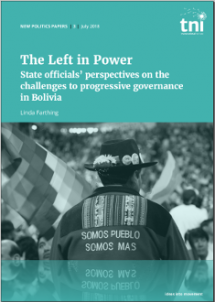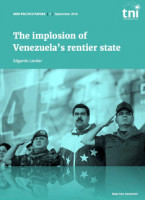Bolivia: The Left in Power State officials’ perspectives on the challenges to progressive governance in Bolivia
Topics
Regions
Social movements need to grapple with not only building successful political parties and winning power but also with using that power strategically to best implement change. This report examines the critical role played by Movimiento al Socialismo (MAS) government employees and the challenges they faced in advancing a social and economic justice agenda within Bolivia. How can progressive government employees remain true to their political ideology while ensuring the execution of a professional and fair public bureaucracy?

Downloads
Authors
When the Movimiento al Socialismo (Movement towards Socialism- MAS) led by coca grower leader Evo Morales won elections in Bolivia late in 2005 on a social and economic justice platform, its rapid rise to power was propelled by social movements that ranked among the world’s most radical. One of several ‘pink tide’ governments that have held office in Latin America during the last 15 years, Bolivia’s new government inherited an impoverished country, the most indigenous in South America, with what the UN Development Program calls a ‘state with holes’ as well as little infrastructure, where 500 years of relentless resource extraction from silver to soy has bequeathed a legacy of severe environmental degradation. A primary commodity exporter with a small internal market, Bolivia holds a peripheral position in the global political economy, with deep, but highly unequal integration into the international economic system.
The state apparatus the MAS took over was, as Centeno et al. describe for much of the Global South, an “incomplete, distorted and malformed” system brought from Spain via colonialism, and then over time re-shaped by local elites. Bolivia has, and in many ways continues to have, what Echebarría and Cortázar call a clientilistic bureaucracy which entails a high degree of politicization in processes of hiring, firing and promotion. Ten per cent of the countries workforce was in the public sector in 2005, and public jobs have always paid better than those in the private sector. The state has a low performance capability and little autonomy from political parties, giving parties an undue influence in determining state capacity. The new government stemmed from a party that was poorly consolidated and in the process of becoming more clientelist and hierarchical when it assumed office. But in Bolivia’s case, it was not just the party that influenced state capacity, as MAS had been set up by social movements to represent their demands. This led to many top government appointments being drawn from social movement leaders, giving their organizations’ internal structures an enormous influence on state operations, particularly in the first MAS government. Many of these social movements tended to be top-down and male-dominated, as well as heavily shaped by patronage relationships.
State performance is also intimately shaped by the demands placed upon it. In Bolivia, social movements had high expectations of what they considered “their” government, which the new administration felt bound to respond to. At the same time, in 2008, the MAS government faced elite-led uprising in the east that at some points threatened to split the country apart.
All of this makes what the MAS has achieved through what it calls ‘the process of change’ even more remarkable, in line with what Seekings describes about the “surprising story” in the expansion of welfare states across the Global South even in the face of widespread rent-seeking (a less pejorative term than ‘corruption’). The Morales government has substantially increased state invention in the economy, almost immediately semi-nationalizing natural gas production, and increasing royalties and taxes paid by transnational companies. This substantially enlarged government revenue, allowing for an unprecedented expansion in services and infrastructure, particularly in long-abandoned rural areas. Twelve and a half years on, the middle class has grown by a million people (10 per cent of the population) and both the government and the economy have tripled in size. Largely thanks to social welfare payments, government investment and a multiplying of the minimum wage, extreme poverty has dropped by half and income inequality has fallen significantly. Bolivia has one of South America’s fastest growing economies, and holds substantial financial reserves per capita, although these have dropped significantly since the global decline in commodity prices after 2013. Its natural resources serve its population more than any other time in its history, more land is controlled by peasant farmers, and indigenous and women’s rights have expanded.
By any gauge, and certainly compared to its predecessors, what the MAS government has achieved is extraordinary, both in terms of emphasis on services for the poorest and the sheer volume of public investment particularly in road infrastructure, hospitals, health clinics, public housing and schools.
However, the country’s underlying economic structure remains largely untouched. “We have the best economy the country has ever had, but it is on a totally capitalist path,” said a former government minister interviewed for this report. While a new class of often indigenous truckers,merchants, contraband traders and small mine owners have become wealthy, and the traditional elites have mostly lost direct political power, their economic clout is largely unchanged. While a left-wing governmenthas increased regulation, banks and construction companies have benefited from the growing economy and agro-industrial elites in the eastern economic powerhouse of Santa Cruz have grown even wealthier.
The government has largely failed in one of its central goals: to diversify a dependent economy through industrialization schemes. These include an Amazon sugar factory that lacks sufficient cane to operate at capacity and a recently built fertilizer plant constructed before markets and transportation infrastructure were secured. Unionization rates have dropped since Morales took power, undermining the once-powerful Central Obrera Boliviana (Bolivian Workers Central, or COB). The informal sector continues to be a powerful force in the economy, encompassing 46 per cent of the labour force, although this has dropped significantly from 62 per cent since Morales took office. Many Bolivians work in small family businesses, often in temporary jobs with few benefits and below the 20-worker threshold for union formation.
Expanded resource extraction is the preferred means for funding increased infrastructure and services, which has created overlapping interests between the government and Bolivia’s traditional elites. The push of exploration, new roads and extractive projects deeper into the country’s remote areas gives Bolivia the highest current rate of deforestation in the region, with the costs borne most heavily by local indigenous populations.
By 2017, the MAS government’s original discourse of societal transformation had given way to trumpeting the newfound economic stability it had delivered. In the process, its political agenda has become more centrist, drifting away from its early commitment to communitarian socialism towards capitalist-orientated growth-promoting policies. Mendoza-Botelho characterizes the government as a ‘neo-patrimonial state’ which has changed the rules of who participates but not the underlying model.
The government has both extended and constricted democratic rights and concentrated power. Institutional controls and oversight tend to have deteriorated, while political participation, integration and substantive equality have improved. Constitutionally-mandated, if limited, indigenous participation in the Legislative Assembly, legislative parity for women, mandated but uneven use of prior consultation, increased indigenous representation at the sub-national level, and indigenous autonomy are all now part of the political landscape. While the 2009 Constitution extends rights – now half the national legislature is female, for example, and indigenous and working-class participation in departmental and national legislatures has mushroomed – these have frequently succumbed to MAS party control directed from the executive branch.


